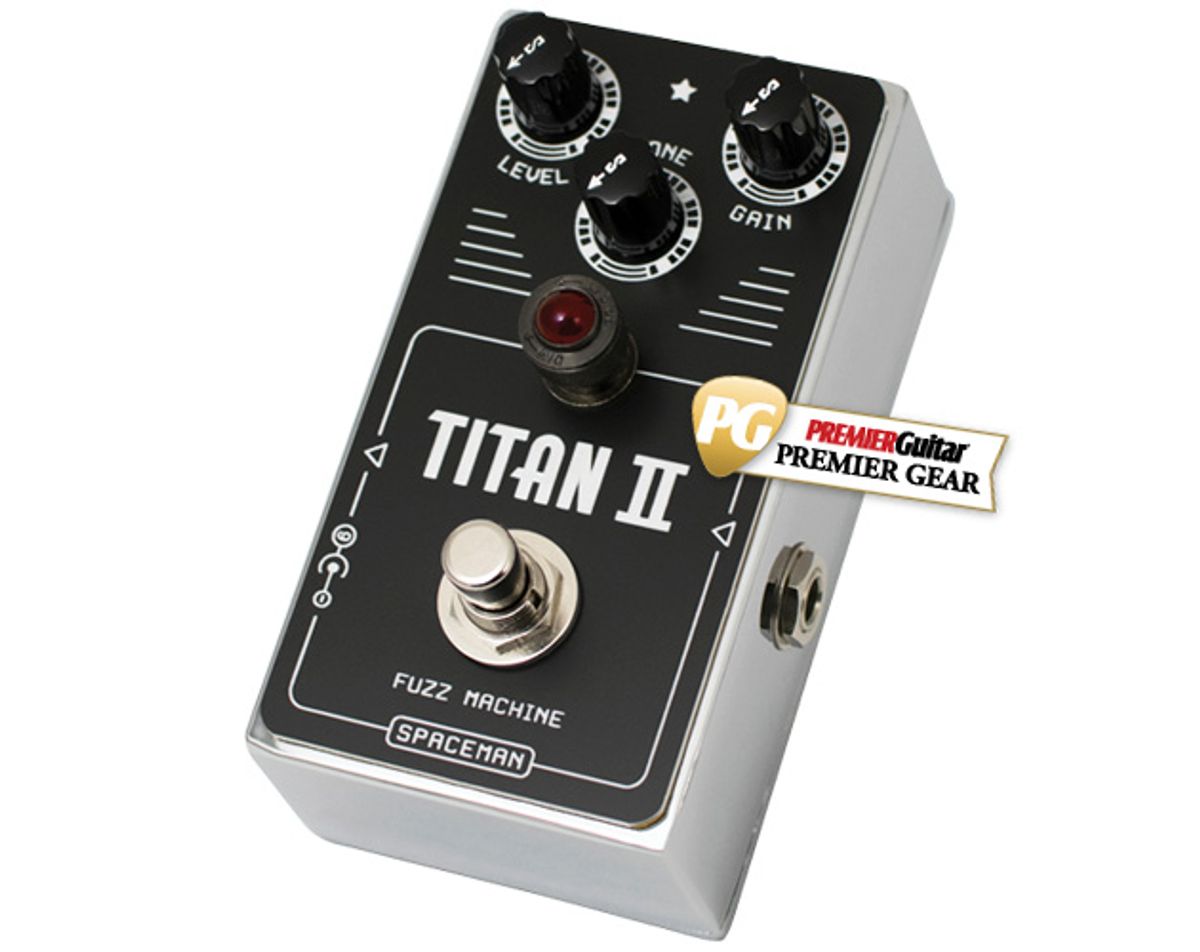
A deviation from fuzztone convention brings explosive and inspiring results.
It’s not for nothing that Spaceman Effects enjoys a following that verges on cultish. The pedal builds are typically immaculate. The designs—loving homages to early-’60s aerospace control panels—make you feel like a test pilot when you’re just dialing in a little extra treble. Above all, Spaceman’s effects usually deliver sonic originality that’s rare amid the clone clutter in the stompbox cosmos.
The Titan II is more straightforward than many Spaceman fuzzes, at least in terms of controls and circuitry. And while you hear hints of familiar fuzz touchstones at many settings—early Big Muff, MkIII Tone Bender, and RAT textures are all part of the Titan II tapestry—it is never quite any of those things. Through its combination of burly, spitty, gruff, and even sophisticated voices, the Titan II delivers sounds and tactile feedback that feels fresh, open-ended, and inspiring.
Built for the Outer Limits
Even if you never open a stompbox except to change a battery, it’s worth a look at the inner workings of the Titan II. Like all Spaceman effects, it’s a textbook study in how to make a stompbox circuit clean, serviceable, and attractive. The discrete circuit is carefully and flawlessly laid out on a through-hole circuit board, which Spaceman glams up with star-engraved silvery overlay. Many of the components themselves look cool, like the gleaming Fine Gold capacitor that’s typically used in hi-fi applications. The part count is appropriately small for a 3-knob fuzz, though six silicon transistors drive the Titan II—presumably to generate the copious gain we’ll discuss in a minute.
The circuit board is mounted so it seems to float free within the enclosure. This design also insulates the vital components from the force of blows on stage and during travel. Even the wiring from the enclosure-mounted footswitch and jacks is fastidious—routed in readily traceable right-angle routes from their points of origin to the circuit board. The 9V AC jack is side-mounted, but that location keeps it far from the circuit board and makes it easy to replace in the unlikely instance of failure. You can also power Titan II with a 9V battery.
The pedal’s exterior is classically Spaceman. It uses the same engraved-plastic-faceplate-over-steel-enclosure configuration that you see on mid-century avionics as well as a red Fender-amp-style indicator lamp. The pots turn with precision and satisfying resistance. And like every Spaceman pedal, it’s fitted with a cool aluminum label that’s stamped with the unit’s serial number.
Full Thrust Fuzz
The Titan II is not a subtle fuzz. Even at the lowest gain settings, it still exudes the menace of a growling dog on a chain. That doesn’t mean it’s incapable of nuance, as we’ll see. But you learn fast that Titan II is louder and more explosive than a lot of standard-bearing fuzzes.
With gain and tone controls at noon, unity gain arrives with the level between 9 and 10 o’clock. What’s really impressive, though, is how much ceiling and boost the Titan II makes available beyond that mark, and incrementally increasing output can feel a little hairy as Titan II drives your signal to speaker-rattling volumes. The remarkable thing is that, beyond whatever natural compression your amp generates in response to this much signal, the tone of the Titan II feels uncompromised—making the level control feel more like a floodgate than a simple potentiometer.
Ratings
Pros:
Unique, versatile fuzz sounds you’d be hard-pressed to find elsewhere. Beautiful build quality.
Cons:
Expensive.
Tones:
Ease of Use:
Build/Design:
Value:
Street:
$249 for silver version
Spaceman Effects Titan II
spacemaneffects.com
Titan II balances all that high headroom with a fuzz flavor that’s varied, rich, and certifiably nasty. It’s particularly mean at extreme gain settings, where it takes on some of the spitty, fractured-harmonic overtones of amp and speaker pushed to their limits. That said, these aren’t the compressed tones that you associate with, say, a Fender tweed at the verge of implosion (though there are hints of it). Instead you get a unique composite of Shin-Ei Super Fuzz octave-up fizz and triangle Big Muff heat (among other things). It’s a splintered and huge sound, but with a surprising amount of air and detail, and a fat wide-spectrum foundation.
This latter feat is what makes Titan II sound distinctive when you A/B it with other fuzzes. It also helps the Titan II shine when you attenuate your signal via guitar volume and tone controls. And while the Spaceman may not have the same warm overdrive growl as, say, a germanium Fuzz Face in these situations, it delivers a brawny, complex overdrive sound and exhibits uncommon sensitivity for a silicon fuzz.
Though it might seem obvious, it bears mentioning that Titan II’s high-gain sounds are usually best communicated through bigger speakers. Out in front of a piggyback Bassman with a 2x12 cabinet, the Titan II’s balance between relatively bruising low end, sizzling, chaotic top end, and growling midrange was very impressive. That balance translates less well in small-speaker, low-wattage combos, however. And where I can typically extract a quintessentially Big Muff- or Tone Bender-like sound using one of those pedals and a Champ, the Titan II felt constrained when paired with the smaller amp and speaker.
The Verdict
The real beauty of Titan II is its distinctiveness. I love the idea of using it to lend contrast and dimension on one side of a stereo recording rig, or for doubling leads or bass lines. And though the very sensitive controls can almost feel vague in certain situations, they lend a lot of flexibility. With practice you can find tones that approximate familiar—and easier-to-control—Big Muff and Tone Bender sounds. What’s more, it stacks beautifully with these types of pedals to generate massive Frankenstein tone concoctions. But Titan II’s airy, open, and harmonically complex sounds are just as powerful on their own. And I won’t be surprised if many players make this pedal a launch pad in pursuit of their own signature sounds.


